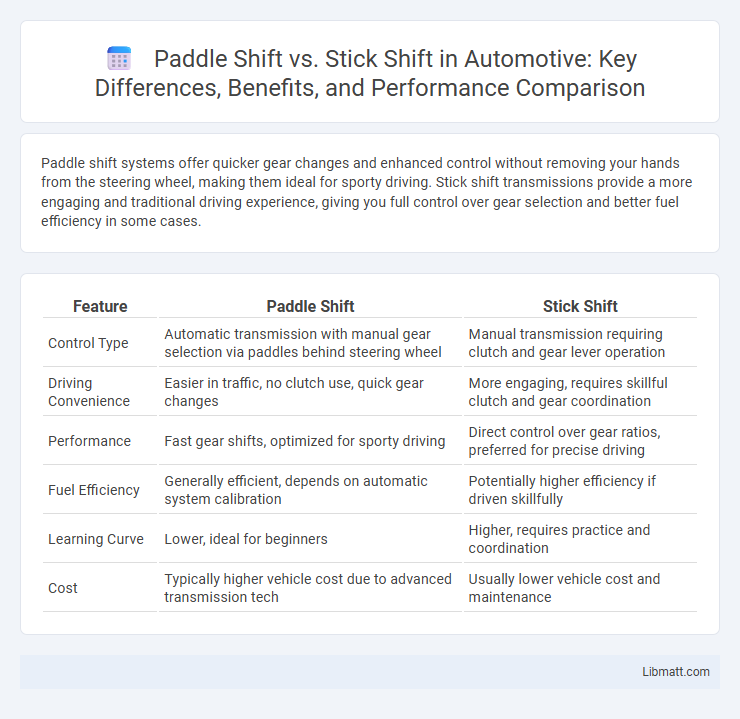Paddle shift systems offer quicker gear changes and enhanced control without removing your hands from the steering wheel, making them ideal for sporty driving. Stick shift transmissions provide a more engaging and traditional driving experience, giving you full control over gear selection and better fuel efficiency in some cases.
Table of Comparison
| Feature | Paddle Shift | Stick Shift |
|---|---|---|
| Control Type | Automatic transmission with manual gear selection via paddles behind steering wheel | Manual transmission requiring clutch and gear lever operation |
| Driving Convenience | Easier in traffic, no clutch use, quick gear changes | More engaging, requires skillful clutch and gear coordination |
| Performance | Fast gear shifts, optimized for sporty driving | Direct control over gear ratios, preferred for precise driving |
| Fuel Efficiency | Generally efficient, depends on automatic system calibration | Potentially higher efficiency if driven skillfully |
| Learning Curve | Lower, ideal for beginners | Higher, requires practice and coordination |
| Cost | Typically higher vehicle cost due to advanced transmission tech | Usually lower vehicle cost and maintenance |
Overview: Paddle Shift vs Stick Shift
Paddle shift systems provide electronic control over gear changes through paddles mounted behind the steering wheel, offering quicker and smoother transitions compared to traditional stick shifts, which rely on manual clutch engagement and gear lever movement. Stick shifts deliver greater driver control and engagement by requiring precise timing and coordination between clutch and gear lever, making them preferred by enthusiasts for a tactile driving experience. Your choice between paddle shift and stick shift depends on whether you prioritize convenience and speed or hands-on control and driving involvement.
History and Evolution of Transmission Systems
Paddle shift technology emerged in the late 20th century, revolutionizing transmission systems by offering drivers gear control through steering wheel-mounted levers, enhancing racing performance and road car convenience. Stick shift transmissions, rooted in early 20th-century automotive design, provided direct manual gear engagement via a gear lever, emphasizing driver skill and vehicle control. Advances in electronic control units and hydraulic systems have enabled paddle shifts to integrate automated clutch operations, marking a significant evolution from traditional manual stick shifts and shaping modern transmission development.
How Paddle Shifters Work
Paddle shifters work by sending electronic signals to the transmission control unit, which then manages gear changes without the need for a clutch pedal, allowing drivers to manually shift gears while maintaining full control. Positioned behind the steering wheel, these paddles enable quick and precise gear shifts, enhancing driving performance and convenience compared to traditional stick shifts that require manual clutch operation. This electronic mechanism optimizes gear change timing and reduces driver effort, especially in automatic or semi-automatic transmissions.
How Manual Stick Shifts Operate
Manual stick shifts operate through a clutch pedal and gear lever mechanism that allows the driver to manually engage and disengage gears, controlling the vehicle's speed and power. The driver presses the clutch pedal to disconnect the engine from the transmission, shifts the gear lever to the desired gear, then releases the clutch to re-engage the power flow to the wheels. This process requires coordination and timing to smoothly change gears, providing direct control over the vehicle's performance and fuel efficiency.
Performance Comparison: Paddle vs Stick Shift
Paddle shifters offer quicker gear changes and smoother transitions, enhancing performance in high-speed driving and racing scenarios. Stick shifts provide greater control over gear selection, allowing skilled drivers to optimize engine power and fuel efficiency. Your choice depends on whether you prioritize precision and control with a manual stick shift or the rapid response of paddle shifters for performance driving.
Driver Engagement and Experience
Paddle shift transmissions enhance driver engagement by allowing quicker, more precise gear changes without removing hands from the steering wheel, providing a sportier and more responsive driving experience. Stick shift vehicles demand greater driver skill and concentration, offering a tactile and immersive connection with the car through manual clutch control and gear selection. Enthusiasts often prefer stick shifts for their direct mechanical feedback, while paddle shifters deliver convenience combined with a performance-oriented feel.
Efficiency and Fuel Economy Differences
Paddle shift transmissions offer quicker gear changes, promoting smoother acceleration and often optimizing fuel efficiency compared to traditional stick shift manuals, which rely on driver skill for timely shifts. Vehicles equipped with paddle shifters typically adjust gear changes electronically to enhance engine performance and reduce fuel consumption. Your choice between paddle shift and stick shift can impact overall efficiency, especially in stop-and-go traffic or performance driving conditions.
Maintenance and Reliability Concerns
Paddle shift systems generally require less maintenance than traditional stick shifts due to their electronic and hydraulic components, which are designed for precision and durability. Stick shifts, on the other hand, may experience quicker wear on the clutch and gearbox components, necessitating more frequent repairs and adjustments. Your choice should consider long-term reliability, as paddle shifts offer smoother operation with fewer mechanical issues, whereas stick shifts demand regular maintenance to ensure optimal performance.
Suitability for Daily Driving and Track Use
Paddle shifters offer quick, convenient gear changes ideal for daily driving, enhancing comfort and ease in stop-and-go traffic. Stick shifts provide greater control and engagement, preferred by track enthusiasts seeking precise gear selection and better vehicle feedback. Daily commuters benefit from the simplicity of paddle shifts, while track drivers favor stick shifts for performance and adaptability.
Choosing the Right Transmission for You
Choosing between paddle shift and stick shift transmissions depends on your driving preferences and needs. Paddle shifts offer quick, convenient gear changes without a clutch pedal, enhancing performance and ease in sports or urban driving. Your ideal transmission balances control, comfort, and driving style for a customized experience.
paddle shift vs stick shift Infographic

 libmatt.com
libmatt.com